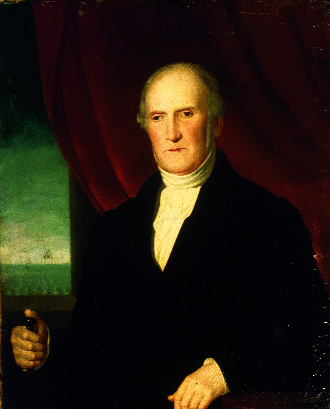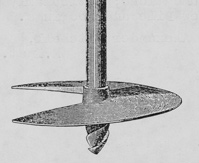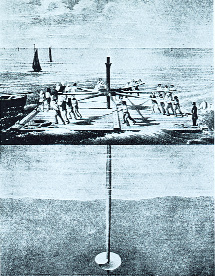Alexander Mitchell (1780-1868): Belfast’s blind engineer
Published in 18th–19th - Century History, Features, Issue 3 (May/Jun 2006), Volume 14Alexander Mitchell, eighth son of William Mitchell and Jane Ferguson, one of thirteen children, was born in William Street, Dublin, on 13 April 1780. His father was inspector-general of barracks in Ireland, a duty that took him all over the country. When at home he relaxed by playing the violin and the harpsichord and often played with young Alexander, calling him ‘my little leprechaun’. About 1787 the family moved to Pine Hill, near Belfast, and Alexander started school at the age of seven, learning writing, arithmetic and later geometry, trigonometry and conic sections, at which he excelled. In 1790 his father died and the family scattered. His mother, the three youngest sons and the remaining daughter rented a cottage a mile from Belfast. From there Alexander attended the Belfast Academy, the famous classical school under Dr Bruce. He remained there for four years, but his sight, which had always been weak, deteriorated rapidly so that by the age of sixteen he was no longer able to read, and by 22 he was blind.
Successful in business
During the rebellion of 1798 Alexander and some of his cousins were evacuated to Scotland to stay with friends. On returning to Belfast in 1801, Alexander married Mary Banks, a neighbour’s daughter, and went to live in Ballymacarrett. His mother was not well pleased with what she considered this rash action, until the first of five grandchildren arrived. By his father’s will he was to receive £500 on reaching the age of 23, so he borrowed £100 to start up a business making bricks. This was so successful that he was able to provide well for his family and to buy property in Belfast, as well as to build eight new houses. When not working he invented several machines for use in brick-making and the building trade, as well as musical instruments, wooden clocks and windmills.
Alexander Mitchell was extremely fond of music; in November 1844 he was elected an associate of the Belfast Anacreontic Society and often went to its concerts with his cousin, George Mitchell. He also played the flute and accordian and sang many old Irish songs, being particularly fond of Irish music. His house was a port of call for many of the enlightened men of the day, including Dr James MacDonnell, a founder of the Linen Hall Library and a personal friend of Henry Joy McCracken. Another visitor was Armagh man Edward Bunting, who organised the famous Belfast harp festival of 1792, recorded the tunes played by the last of the old Irish harpers and published them in 1796.

Alexander Mitchell
When Alexander met the great Scottish engineer Thomas Telford (1757–1834) in London, he was asked what country he was from and replied that he was from Ireland, later noting that he was proud to be so, adding ‘Erin go bráth, I will never deny you’. He continued in the brick-making business for some 30 years until 1832. It was his invention of the screw pile, however, that brought him world fame.
Mitchell’s screw pile system
Alexander, being of an inventive mind, often thought that many lives could be saved if a method could be devised of building lighthouses on shoals or sandbanks. This led to his ingenious invention of the screw pile, in which he was said to have been influenced by the corkscrew and perhaps the force necessary to open a bottle of wine. With his son John (then aged nineteen) he hired a boat and secretly rowed out to a sandbank in Belfast Lough; he screwed down a screw pile, leaving the top end showing above water, and early next morning returned to find it still firmly fixed in position. He carried out a second successful trial of his invention in spring 1833, and soon after went to London to have it patented, but had difficulty getting it adopted. In 1838, through his friendship with James Walker, a civil engineer engaged in the development of the port of Belfast, he was invited by the Corporation at Trinity House, London, to lay the foundations of the Maplin Sands lighthouse in the Thames estuary using the screw pile system. With the assistance of his son John, now also an engineer, the nature of the ground was ascertained using a boring rod about 30ft long and one and a quarter inches in diameter at its lower end, which was screwed down to a depth of 27ft using four cross-levers.
The piles were 6in. in diameter and about 20ft in length; each pile had attached to its lower end a cast-iron screw 4ft in diameter, and one was placed at each point of an octagon with one in the centre. A raft of 30ft2 was towed to the spot where the pile was to be screwed down and held in position by wraps. The pile was then placed upright through an opening cut through the raft. The nine piles were screwed 22ft down by men using a capstan keyed onto the pile.

The tip of Mitchell’s screw pile.
Mitchell, a fine singer, often joined the men in singing sea shanties as they manned the capstan bars. The superstructure was completed by James Walker and the lighthouse was first lit in February 1841.
The next contract was to build a complete lighthouse on the north wharf bank of the River Wyre off Fleetwood. It was commenced on 15 November 1839 and was first lit on 6 June 1840. The foundation was formed of seven screw piles, six at the points of a hexagon and one in the centre. Since the sand was much harder than at Maplin Sands, piles of hammered iron 5in. in diameter were used, with a screw 3ft in diameter at the foot of each. These screws were sunk 13ft into the bank below the surface. The house was 22ft in diameter (leaving a boardwalk around) and 8ft high, the lantern above it being 11ft in diameter, and the platform 45ft above the sand. The lighthouse was abandoned in 1948 after a fire, when the lightkeeper was rescued by the local lifeboat crew.
Failure at the Kish
A rare disappointment was his failure to erect a lighthouse on the Kish Bank off Dublin Bay, for although the piles were successfully placed, for various reasons they were not properly braced and during a heavy gale in November 1842 a portion of the bank shifted and the erection collapsed. In the summer of 1844 a screw pile lighthouse, serving also as a pilot station, was successfully placed on Holywood Bank in Belfast Lough. Similar to that at Fleetwood except that the house was longer and the lantern smaller, it was first lit in November under the Belfast Ballast Board. The cost was £1,300, which, because of Mitchell’s local patriotism and sense of place, was the bare minimum. It was destroyed on 12 March 1889 by the earl of Ulster .
The earl of Courtown, being anxious to relieve some of the distress caused by the potato failure and to encourage the fishing and shipping trade, applied to the Board of Works for assistance, and they eventually called on the services of Mitchell and his son. In the summer of 1847 they constructed a screw pile jetty at Courtown Harbour, Co. Wexford. When it was completed the earl commented:
‘At first sight it appears too flimsy to resist the sea, but a little reflection convinces one that its very slightness prevents its offering any resistance to the sea which washes through it.’
The new jetty ran 260ft beyond the old solid stone jetty and proved a great success until it was washed away in a storm in January 1869.
In 1848 Alexander Mitchell was elected a member of the Institution of Civil Engineers and received the Telford silver medal for a paper he read on his inventions on 22 February, entitled ‘On submarine foundations; particularly the screw pile and moorings’. His system was also used for fixing beacons and mooring ships, and could be used on any kind of ground except rock. It was so successful that it was used worldwide; examples include the breakwater at Portland, the long viaduct and bridges on the Bombay and Baroda railway, the Indian telegraph system and the Madras pier. Among Mitchell’s other lighthouses was one erected in Dundalk Bay in 1848, which is still in use and maintained by the Commissioners of Irish Lights. Early in 1850 he built the Sheerness lighthouse on the Chapman Sands in Kent, and returned the following year to build one at Queenstown, Co. Cork. Known as the Spit Bank lighthouse, it had a fixed red light established on 1 March 1853, 32ft above high water. It was seriously damaged in December 1978 by MV Levensau and was successfully repaired. In December 1985 it was taken over by the Cork Harbour Commissioners.
Went out in all weathers
During these years Alexander’s family were very concerned about his safety, as he went out in all weathers to examine his work, oblivious to the dangers of travelling in a small boat in rough seas, stepping onto and climbing a ladder onto a half-built lighthouse, a hazard even to anyone with sight. A few times he did fall into the sea; once, when going to the lighthouse in Belfast Lough, he fell over the side but came up at the other side of the boat, ‘cool and collected, with his hat lost but his stick in his right hand’, as his son later recalled.
In August 1853 he moved with his family to Heysham to build a lighthouse in Morecambe Bay, and while his son carried on with the major preparations he used his spare time in perfecting the screw-propeller, which he patented early in 1854. This resulted in increased speed and less coal consumption in steamships. He granted the Screw Steamship Company the free use of his improved screw-propeller in all their ships. In June 1854 he returned from Heysham to live in Victoria Terrace, Holywood, Co. Down.

The pile was placed upright through an opening cut through a raft and screwed down by men using a capstan keyed onto the pile.
In 1855, at the Great Paris Exhibition, he was awarded the silver medal for his invention of the screw mooring. On 12 April 1858 a paper of his on architectural foundations was read at the Literary Society. When his daughter Mary died he went to live at Farm Hill, Holywood, with his daughter Margaret, wife of Professor William Burden. In May 1868 they moved to Glendivis, where Alexander Mitchell died on 25 June; he was buried in Clifton Street graveyard.
Captain Washington of the Royal Navy, writing on 29 February 1848, observed:
‘It has fallen to my lot in visiting all the harbours in Scotland and Ireland and a great part of those in England, to have seen and examined the screw pile lighthouses on the Maplin Sands at the entrance to Fleetwood and at Belfast, and I can bear testimony to their utility and their stability.’
A Mr Walker CE, commenting on the paper read to the Institution of Civil Engineers on 22 Febraury 1848, remarked that:
‘Mr Mitchell’s conduct was to be eulogised, and his ingenuity and perseverance were to be admired; and when the physical obscurity under which he laboured was considered, he was entitled to more credit than would be accorded to men who could see the progress of everything around them, and were prepared to take advantage of the ideas of others in aid of their own.’
PRO TANTO QUID RETRIBUAMUS
Jim Blaney is a local historian and writer.
Further reading:
F.J. Bigger, Alexander Mitchell, the famous blind engineer of Belfast (Belfast, 1907).
House of Commons Select Committee on Shipwrecks 1843, vol. 9.
House of Commons Select Committee on Lighthouses 1845, vol. 9.
T.G. Wilson, The Irish Lighthouse Service (Dublin, 1968).
















